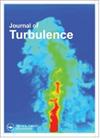一种空间衰减自由流湍流的预测方法
IF 1.6
4区 工程技术
Q3 MECHANICS
引用次数: 0
摘要
本研究导出了一组简单的方程,能够量化和预测自由流湍流(FST)的空间衰减。预测方程基于湍流动能(TKE)耗散率的无粘估计。新的模型方程组包括积分长度尺度和湍流动能作为变量,并且优于之前的衰变方程组,因为与这些方程组不同,它们不依赖于任何物理网格参数(b或M)。当将这组新的方程与17组(2个活动网格、2个多尺度网格、9个方形截面网格和4个圆形截面网格)先前公认的实验数据进行比较和验证时,包括与网格生成湍流相关的数据,并涵盖了大范围的湍流雷诺数(ReLu 0)(7.5×101至6.9×104),其中Lu 0是初始积分长度标度,显示出非常好的一致性(在±15%以内)。这组相关方程可用于估计FST流中的局部和/或初始湍流动能和积分长度标度(Lu),并定位流域内预计将出现几乎恒定湍流条件的区域。本文章由计算机程序翻译,如有差异,请以英文原文为准。
A prediction method for spatially decaying freestream turbulence
A simple set of equations, capable of quantifying and predicting the spatial decay of freestream turbulence (FST) is derived in the current study. The prediction equations are based on the inviscid estimate of the turbulent kinetic energy (TKE) dissipation rate. The new set of model equations includes the integral length scale and the turbulent kinetic energy as variables and is superior to the previous set of decay equations because, unlike those, they are not dependent on any physical grid parameters (b or M). This new set of equations, when compared and validated against 17 sets (2 active grids, 2 multi-scale grids, 9 square-cross-sectioned grids and 4 circular cross-sectioned grids) of previous, well-accepted, experimental data, including those relating to grid-generated turbulence and covering a wide range of turbulent Reynolds number (ReLu 0) (7.5 × 101 to 6.9 × 104), where Lu 0 is the initial integral length scale, showed very good agreement (within ±15%). This set of correlation equations can be used to estimate the local and/or initial turbulent kinetic energy and integral length scale (Lu ) in an FST flow and to locate the region within a flow domain where nearly-constant turbulence conditions are expected to prevail.
求助全文
通过发布文献求助,成功后即可免费获取论文全文。
去求助
来源期刊

Journal of Turbulence
物理-力学
CiteScore
3.90
自引率
5.30%
发文量
23
审稿时长
6-12 weeks
期刊介绍:
Turbulence is a physical phenomenon occurring in most fluid flows, and is a major research topic at the cutting edge of science and technology. Journal of Turbulence ( JoT) is a digital forum for disseminating new theoretical, numerical and experimental knowledge aimed at understanding, predicting and controlling fluid turbulence.
JoT provides a common venue for communicating advances of fundamental and applied character across the many disciplines in which turbulence plays a vital role. Examples include turbulence arising in engineering fluid dynamics (aerodynamics and hydrodynamics, particulate and multi-phase flows, acoustics, hydraulics, combustion, aeroelasticity, transitional flows, turbo-machinery, heat transfer), geophysical fluid dynamics (environmental flows, oceanography, meteorology), in physics (magnetohydrodynamics and fusion, astrophysics, cryogenic and quantum fluids), and mathematics (turbulence from PDE’s, model systems). The multimedia capabilities offered by this electronic journal (including free colour images and video movies), provide a unique opportunity for disseminating turbulence research in visually impressive ways.
 求助内容:
求助内容: 应助结果提醒方式:
应助结果提醒方式:


